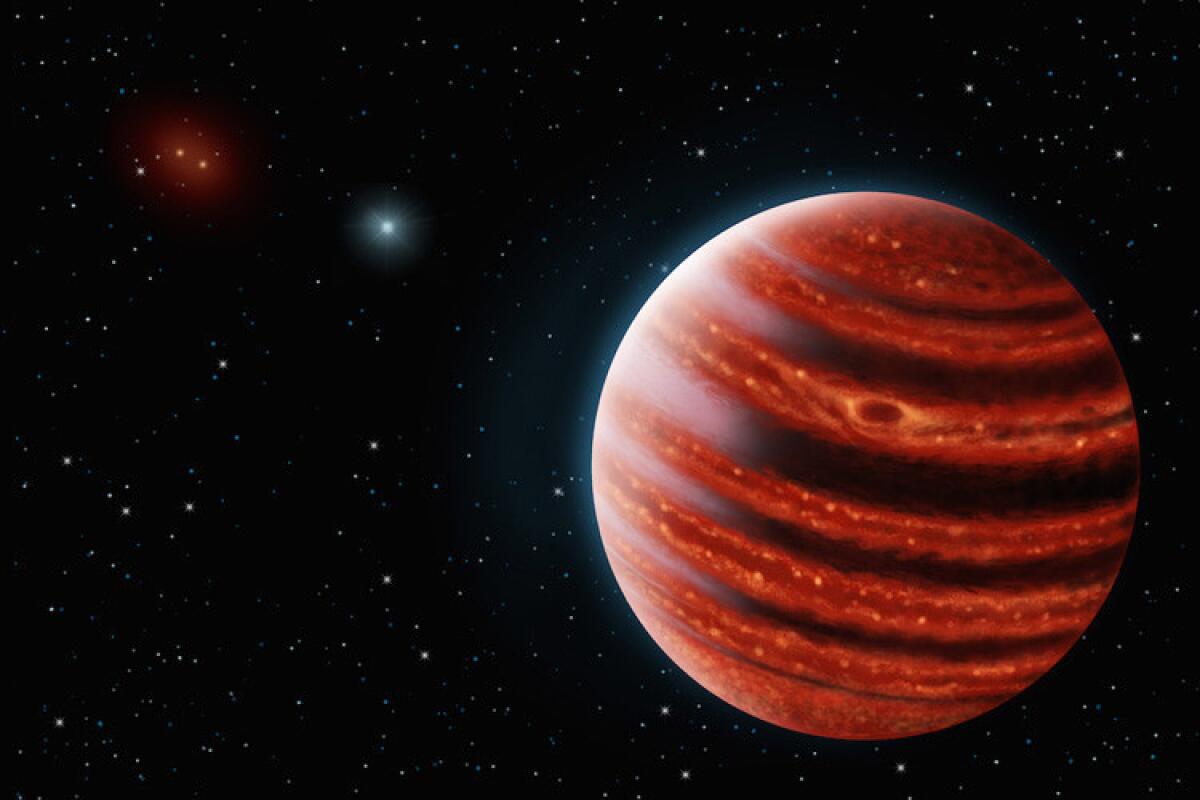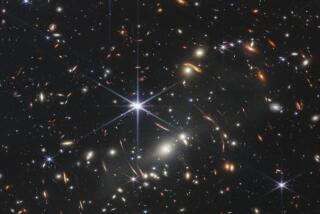Jupiter’s methane-shrouded cousin spotted around distant star

This artist’s conception shows the Jupiter-like exoplanet 51 Eridani b, whose hot layers deep in its atmosphere glow through clouds.
Maybe our solar system isn’t such an oddball after all. As planet-hunting telescopes have scanned the starry heavens, they’ve discovered all kinds of strange worlds that are unlike those in our own solar neighborhood: hot Jupiters, super-Earths, mini-Neptunes. But now, astronomers say they’ve spotted a remarkably close analogue to our own planet Jupiter -- and even gotten a look at its methane-rich atmosphere.
The planet, 51 Eridani b, was the first to be found using the Gemini Planet Imager. The discovery, described in the journal Science, could give researchers deeper insight into the makeup of such exoplanets -- as well as a potential glimpse into the evolution of our own solar system.
“It really, as far as we can tell, is pretty much like what Jupiter looked like at that age,” study leader Bruce Macintosh, an astronomer at Stanford University, said of the young planet. “And by studying the light from it ... we can hope to understand the process that made it form.”
The gas giant’s star, 51 Eridani, sits about 100 light-years away in the constellation Eridanus (nearby Orion). The planet is thought to hold roughly twice the mass of our own one-eyed Jupiter and lies a little farther out, past where Saturn would sit. Its atmosphere holds water vapor and gives off the strongest methane signature yet detected on an exoplanet. (Jupiter also features methane and water vapor in its atmosphere.)
Astronomers have discovered many other gas giant planets -- particularly with NASA’s Kepler spacecraft, which has turned up more than 1,000 confirmed exoplanets of all types and sizes -- but those behemoths tend to be very close to their host star. That’s very different from the planets around our home star, where the small, rocky ones stay close to the sun and the large, gassy ones fill up far more distant orbits.
That’s partly because the Kepler spacecraft, launched in 2009, used the transit method to pick out planets: It would wait for the near-imperceptible darkening that happened when a planet passed in front of its star, blocking a tiny bit of starlight. A dip that happened at regular intervals signaled an orbiting planet. But the spacecraft was hobbled in 2013 with about four years of data, which meant that it could only find planets that were close to their star, because distant worlds take too long to orbit. Jupiter, for example, takes nearly 12 Earth-years to circle the sun. (Kepler has begun a new career with the K2 mission since then.)
While Kepler’s method was powerful, Macintosh said, it was also “frustrating because you don’t actually get to see the planet, and you don’t get to learn, for example, what it’s made of.”
The Gemini Planet Imager, installed on the Gemini South Telescope in Chile, uses a different method: Rather than indirectly detecting a planet when it’s in front of its star, the imager actually looks directly for the planet when it’s off to the side of the star. So instead of looking for the missing light, they’re looking for a little extra glow.
This method is actually better for planets that are farther from their star, which makes Gemini’s method and Kepler’s method somewhat complementary.
But directly capturing the light from a distant exoplanet is no easy task. First off, the astronomers have to use powerful software to block out all of the starlight and look for the tiny, dim signal coming from the planet itself, which is about a million times fainter than its host star.
That’s akin to looking for “a firefly next to a lighthouse, or a match next to a searchlight,” said Macintosh, the imager’s principal investigator.
Also, this technique can only be used on planets around very young stars, because it relies on detecting the infrared light that is coming from the hot planet, still glowing by its own formation process.
“The biggest challenge is that the planets, to be visible, have to be young -- meaning like 100 million years or less,” Macintosh said. In the Milky Way, “things that are young are rare, compared to things that are old. Only 1% of the stars in our galaxy or less are young enough that we can see planets around them.”
This planet’s star is still young, an estimated 20 million years old -- an infant compared with our own nearly 4.6-billion-year-old solar system. Because the planet was still glowing, the scientists were able to pick out its infrared light -- even though that light filled just one pixel in the imager.
This planet may actually look a lot like Jupiter first did when it formed, Macintosh pointed out. Right now, it’s about 400 degrees Celsius. When it first formed, it was probably around 2,000 degrees. By the time it gets to Jupiter’s age, it will probably have cooled to a similarly frigid temperature as the gas giant, somewhere around minus 150 degrees.
In fact, this planet may provide some insight into how our own banded gas giant grew -- and perhaps help solve some long-standing mysteries around planetary formation.
“Astronomers have a lot of competing theories for how planets form. One of the nice things about this [planet] is it’s young enough and small enough that it remembers the process that formed it,” Macintosh said. “If it formed really quickly, it would be extra bright; if it formed slowly like we think Jupiter would have, it might be significantly less bright.”
It will probably take observing for a year or two more, he added, to determine whether 51 Eridani b’s planetary system formed the same way our solar system did.
If 51 Eridani b is akin to Jupiter, then could there be an Earth-like planet closer in to its star? It’s not out of the question, the astronomer said.
“It is kind of interesting,” Macintosh said. “This is a system where we don’t really know what’s going on inside it -- whether there’s an Earth in there or not -- but there should be room for an Earth.”
Packing your bags for another planet? Follow @aminawrite for more science news







